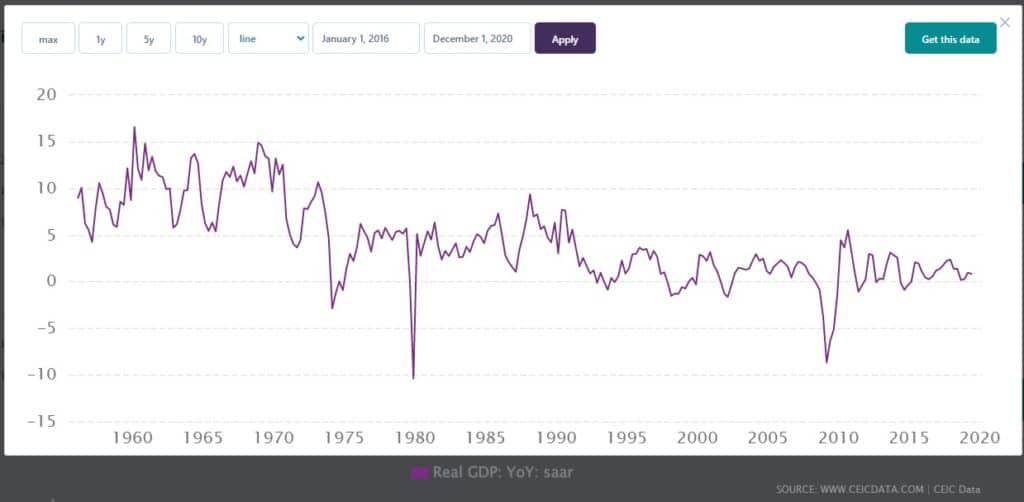We will discuss 5 expansionary monetary policy examples in real life across some major economies or countries. But first what is expansionary monetary policy?
Table of Contents
What is expansionary monetary policy?
Expansionary monetary policy is a macroeconomic policy that increases the total supply of money in the economy. This then leads to a rise in aggregate output and an expansion of the economy.
This policy loosens the conditions of the financial sector so that capital is allocated to entrepreneurs who need it for expansion, instead of sitting idle in banks.
Why is an expansionary monetary policy used?
An expansionary monetary policy is generally undertaken by central banks when they believe that their country’s economic growth is too slow to reach the full employment level.
Central banks often expand the money supply through open market operations, which is where they buy or sell government bonds on the open market. This then increases the banks’ reserves, and they can then increase lending if they want to further the expansionary policy.
Expansionary monetary policy examples
There are many expansionary monetary policy examples in real life. We will consider some examples of some major economies and their effects on their economies.
Expansionary monetary policy examples in Japan
An expansionary monetary policy example occurred in Japan from 2001 to 2006. In 2000, Japan experienced a stock market crash and the economy fell into recession. In order to fight this recession, the Bank of Japan (BOJ) cut its discount rate from 0.5% in January 2001 down to 0.25% by March 2003 and kept it there until late 2004, when inflation began to increase.
During this expansionary period, the broad money supply rose 34% while GDP increased modestly by 1%. However, in 2006, BOJ felt that it had gone far enough and began tightening policy to avoid inflationary pressures from taking hold. The expansionary monetary policy was over and the economy fell back into recession during 2007 and stayed until 2009.
The 2nd example of expansionary monetary policy occurred in modern-day Japan from 2013 to 2016. The Japanese yen had been experiencing deflation for much of this period, which contributed to many companies’ low levels of expansion. However, when Shinzo Abe became prime minister in 2012, he encouraged expansionary monetary policy through inflation targeting and more quantitative easing.
The expansionary policies had the intended effect of stoking inflation to its desired 2% level while reducing long-term interest rates and spurring economic expansion. By 2016, the real GDP growth rate was 1.5%, its highest in recent years, while CPI hit 1.2%.

Expansionary monetary policy examples in the U.S
Another expansionary monetary policy example occurred in the U.S. during the Great Depression. After years of deflation, President Franklin D. Roosevelt’s administration began expansionary policies through gold sterilization. During this expansionary period, the Federal Reserve increased the money supply and ended up devaluing the dollar in terms of gold. While expansionary, it did not end the deflation and unemployment that characterized the period.
A fourth expansionary monetary policy example occurred in the U.S. during the early 1980s when Paul Volcker was chairman of the Federal Reserve Board. One of Volcker’s first actions as chairman was to sharply hike interest rates beginning in 1979, which essentially created a recession in 1981-1982. However, this action was intended to undercut inflation, which had peaked at 13.5% the previous year.
Fast forward to October 1979, when Fed chairman Paul Volcker caught everyone by surprise with a sudden half-point hike in the discount rate from 9% to 10%. He followed this up with a one-point increase in the federal funds rate on Dec. 16, to 12%, and two more one-point increases in January 1980. The Fed’s expansionary monetary policy was designed to undercut inflation but ended up causing a deep recession with unemployment rising above 10 percent.
Another expansionary monetary policy example is seen in the U.S. after the Great Recession of 2008, where expansionary fiscal policies and expansionary monetary policies had a large effect on the economy. The expansionary fiscal policy included $800 billion of stimulus spending and expansionary monetary policy had the goal of lowering interest rates and increasing liquidity to avoid deflation and spur economic expansion.
These expansionary fiscal and expansionary monetary policies were successful as GDP growth increased from -2% in 2009 to 2.4% in 2010 and 4% in 2011. Inflation also hit 3% during 2011, its highest level since 2008.
In another expansionary monetary policy example from the U.S., expansionary fiscal policies were paired with expansionary monetary policy from 2001-2004 under President George W. Bush to spur economic growth after the dotcom bubble burst in 2000. The expansionary fiscal policy included tax cuts and expansionary monetary policy lowered interest rates to avoid deflation after the 9/11 terrorist attacks in 2001, with the federal funds rate falling from 6% in August of that year to 1% in 2003.
After expansionary fiscal and expansionary monetary policies, the economy grew by 11.5% in 2003, the highest expansion rate since 1984. The inflation rate also hit a 30-year low of 1.1%.